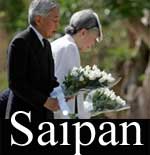 Japan emperor on Saipan to mourn WW II dead
Japan emperor on Saipan to mourn WW II dead
SAIPAN – Japanese Emperor Akihito began a pilgrimage to the site of one of World War II’s most decisive battles on Monday to pay tribute to those who died in a conflict that still haunts Tokyo’s ties with Asian neighbors, 60 years after its end.
The journey to the U.S. territory of Saipan — the first by Akihito outside Japan to mourn war dead — coincides with a chill in Tokyo’s ties with China and South Korea, where many feel Japan has not owned up to its wartime atrocities.
“Sixty-one years ago today, a fierce battle was still being fought on this island. Our hearts ache when we think of those people who fought at a place where there was no food, no water, and no medical treatment for the wounded,” Akihito said before he and Empress Michiko left Tokyo.
Akihito attends annual ceremonies to mark the Aug. 15 anniversary of the war’s end, and in 1995 he paid respects at war memorials in Tokyo, Hiroshima, Nagasaki and Japan’s southern island of Okinawa to mourn war dead.
“This time, on soil beyond our shores, we will once again mourn and pay tribute to all those who lost their lives in the war and we will remember the difficult path the bereaved families had to follow, and we wish to pray for world peace,” he said.
Japanese veterans and families of war dead — key support groups for Prime Minister Junichiro Koizumi’s ruling party — are pleased that Akihito, 71, son of the late Emperor Hirohito in whose name their comrades fought and died, is making the journey.
“Those who fought then were soldiers of the emperor, and they and we who remain are happy that he is coming to comfort their souls,” said Seiichi Oike, 87, who was one of only about 2,000 Japanese who survived the bloody 24-day Battle of Saipan in 1944.
A black-suited Akihito and Michiko, wearing a flowing white dress, later met with about 40 members of Japanese veterans’ and war bereaved groups, listening carefully, nodding and commenting as they related their wartime experiences.
Saipan, controlled by Japan after World War One and considered vital to Japan’s homeland defense, was the site of fierce fighting from June 15 to July 9, 1944.
U.S. forces wanted the island as a base from which its new B-29 bombers could strike Japan’s mainland to the north.
Some 43,000 Japanese soldiers and 12,000 Japanese civilians died in more than three weeks of intense battle, according to Japanese figures. Many committed suicide rather than surrender in shame.
More than 5,000 Americans died in the battles for Saipan and nearby Tinian and the naval Battle of the Philippine Sea, along with some 900 native islanders, including infants and elderly.
JUDGING THE PAST
Some natives of the island, where older people recall the days of Japanese rule when they were taught to revere Hirohito as a god, welcomed the royal visit. Others were less enthusiastic.
“I think they’re coming for their own purpose,” said Margarita Wonenberg, a native of Saipan whose father worked for his keep — but no pay — in sugarcane fields when the island was under Japan’s control.
Japanese officials have stressed that Akihito and Michiko will mourn all those who lost their lives in the Pacific conflict, whatever their nationality.
Whether the message gets across remains to be seen.
In a sign that history still rankles, Korean residents of Saipan had asked that the emperor visit a memorial on the island to their compatriots who lost their lives in the war.
About 1,000 Korean laborers were brought to Saipan against their will while it was held by Japan.
“They say they have their memorial but it’s for everyone who died in World War II regardless of nationality,” Jin Koo Cho, director of the Korean Association of Saipan, told Reuters.
“But we asked them to show respect for Koreans in our way, not their way.”
The royal couple on Tuesday will visit memorials dedicated to American and local war dead as well as Japanese.
Among the sites are two rocky heights, now known as Banzai Cliff and Suicide Cliff, where Japanese soldiers and civilians — women and children included — leapt to their deaths.
Japanese before the war had been taught a nationalist ideology that made it a virtue to die for the sake of an emperor worshipped as a living god. Propaganda about certain rape and torture if taken prisoner by Americans was also common.
“If you think of it now, it seems a mistake, but you can’t judge them by the way things are now,” said veteran Oike, who was wounded and rescued by an American soldier.
The huge loss of life was repeated on Iwo Jima and Okinawa the next year and helped persuade the United States to drop atomic bombs on Hiroshima and Nagasaki in August 1945, prompting Japan’s unconditional surrender.
The planes carrying both bombs took off from Tinian.

ATTENTION READERS
We See The World From All Sides and Want YOU To Be Fully InformedIn fact, intentional disinformation is a disgraceful scourge in media today. So to assuage any possible errant incorrect information posted herein, we strongly encourage you to seek corroboration from other non-VT sources before forming an educated opinion.
About VT - Policies & Disclosures - Comment Policy



